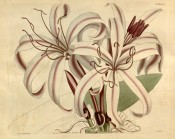Crinum x amabile Donn
The identification of this plant is uncertain. It may be Crinum amabile Donn ex Ker Gawl., regarded as a synonym of Crinum asiaticum L. var. asiaticum by The Plant List. However, the plants described and illustrated as Crinum amabile in both the Botanical Magazine and the Botanical Register have deep red striped flowers so it seems more likely that Crinum x amabile Donn is their subject. For more information on Crinum asiaticum see Crinum pedunculatum R.Br.
Crinum x amabile Donn is a sterile hybrid. Small, long-necked bulbs produce lance-shaped leaves to 1.2m long and 10cm wide, tapering to a point, and a scape to 90cm tall bearing an umbel of up to 30 very fragrant flowers, to 10cm long, with a bright red cylindrical tube and purplish-red-tinged white segments with a crimson central band. [RHSD, Hortus].
Horticultural & Botanical History
Introduced to Britain in 1810. [JD]. ‘Comes very near to the Crinum latifolium of Linnaeus, injudiciously transferred to the genus Amaryllis by Willdenow; but is a far larger plant, and differs in the form of the leaves. That species we believe has not yet found its way into our collections: but there is a figure of it among Dr. Roxburgh’s unpublished drawings of Coromandel plants in Sir Joseph Bank’s library. The specimen from which our drawing was made, flowered last July, in Sir Abraham Hume’s hot-house at Wormleybury. Introduced by Dr. Roxburgh, in 1810, from the East-Indies. We have thought it right to add a diminished outline of the whole of this magnificent plant, in a separate plate, which accompanies that of a part of its inflorescence of the natural size.’ [BM t.1605/1813]. This plant was considered by the author, Ker Gawler, to be identical to the plant first described by Donne in his Hortus Cantabrigensis [ed.6. p.83/1811] but is described as synonymous with Crinum asiaticum var. asiaticum by The Plant List.
A sterile plant is described in The Botanical Register by Roxburgh: ‘Germen inferior, oblong, 3-celled, with a few ovules in each cell, attached to a fleshy receptacle, which appears to originate in the centre from the axis, but their real insertion is into the walls of the germen. Style declining, the length of the deeply coloured equably incurved slender filaments: stigma small, perforated, and obscurely 3-lobed, The ripe seed-vessel has not been yet found; they have continued abortive in Bengal. - Native of the interior of Sumatra, from whence it was sent by the late Dr. Charles Campbell to the Botanic Garden at Calcutta, where it thrives and flowers and blossoms at various seasons of the year. It is the largest and by far the most beautiful species of Crinum I have yet met with.” [BR f.679/1822 as Crinum amabile var. augustum].
History at Camden Park
The first record of Crinum amabile is a desideratum to Loddiges Nursery, 6th January 1845 [MP A2933-2, p.28] and this may be the source. It was certainly grown at Camden by 1854 as it was among a hand-written list of plants in an 1850 catalogue now in the Mitchell Library and signed on the front ‘Wm. Macarthur, 23rd Dec. 1854’. [ML 635.9m]. Crinum amabile was also ticked in a bound volume of the Horticultural Register, September 1831. Although this originally belonged to James Bowman, this possibly signifies that the plant was grown by Macarthur earlier than 1854.
Notes
Crinum amabile Roxb. ex Steud. (1840) = Crinum latifolium Andr. See Crinum scabrum Herb.
Click here for a photograph of Crinum amabile growing in the Vietnam highlands at Dalat in 2008.
Published Apr 26, 2009 - 02:03 PM | Last updated Jun 29, 2012 - 01:08 PM
| Family | Amaryllidaceae |
|---|---|
| Category | |
| Region of origin | East Indies |
| Synonyms | |
| Common Name | |
| Name in the Camden Park Record | Crinum amabile
|
| Confidence level | high |
